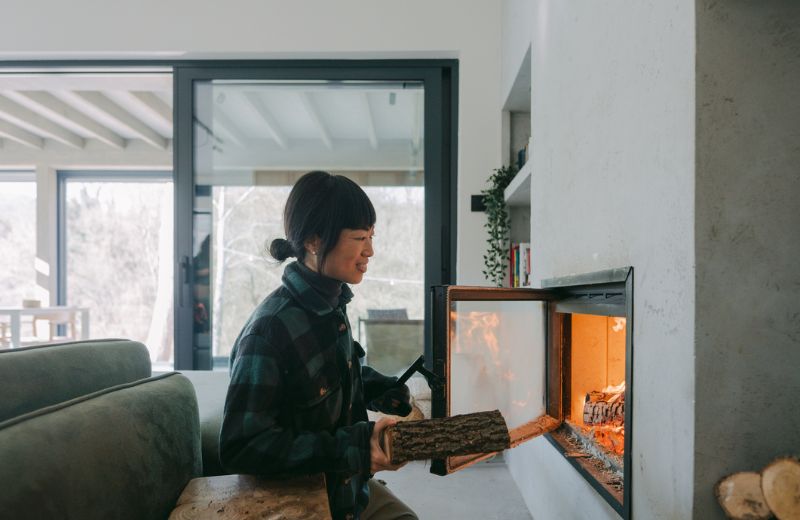%20(26).jpg)
How to Prepare for your First Winter in Your New Home
When you are a new homeowner, the tasks and expenses associated with taking care of your home can seem overwhelming. From routine maintenance and everyday minor repairs to major renovations and upgrades, you may feel like homeownership is a part time job. And winter weather can be especially destructive on homes, requiring special preparations to keep your home—and yourself—safe and protected.
If you’re preparing to spend the first winter in your new home, this blog is for you. We’ll outline major preparations to get your home ready for cold weather, from ice storms to the occasional heavy snow, as well as winter homeowner safety tips and advice on how to save money on heating expenses, even in an older home.
Home Winterization Tips for New Homeowners
If you moved into your home in warmer months, you may notice that, as days get shorter and colder, living in your home can feel entirely different. Your favorite reading nook may become drafty, rooms that were once hot are now unpleasantly cold, and your previously lush garden is now brown. So how do you make the most of these colder months, increasing your home comfort and ensuring that winter’s harsh weather doesn’t leave your home worse for wear? Here are some key ways to get your property ready for the season.
Add Insulation
Chances are, your inspection report gave you some details on the quality of your insulation, highlighting areas where insulation could be improved or replaced. If not, you may want to have a home energy assessment completed to see where most of your home’s heat loss is occurring. There are many state and local programs that can help you evaluate your home’s energy efficiency. Many of these programs also offer weatherization services, sometimes at no cost to the homeowner, as well as additional tips for winterizing your home.
These include:
- Arkansas Department of Energy and Environment Weatherization Assistance Program
- Missouri Department of Natural Resources State Weatherization Plan
- Southwestern Electric Power Company Weatherization Program
Consider the following:
- Attic: Does your home have an attic with batting insulation between the joists? Swapping out your current insulation for one with a higher R value can be a quick and affordable way to drastically improve your home’s energy retention.
- Pipes: Does your home have pipes running through uninsulated areas, including the attic, basement, or crawl spaces? Pipe insulation isn’t expensive, and can not only reduce heat loss, it can also help protect against freezing conditions. While you’re at it, don’t forget about your water heater.
- Outlets and switches on exterior walls: It’s not uncommon for indoor light switches and outlets that are on exterior walls to lack insulation. As weather gets cooler, you may even be able to feel that walls around them feel colder to the touch. After turning off the electric to the outlet or switch from your electrical panel, you can unscrew the plate to see if insulation is needed. Spray foam insulation or socket sealers can prevent air leaks.
Here are a few easy ways to winterize your doors and windows:
- Caulking. Gaps and cracks around doors and windows can be a major source of heat loss. Caulk can be used to fill these gaps, an easy DIY task. Note—they may be hiding behind trim. If your trim isn’t flush with the wall, consider caulking this space, too.
- Weather-stripping. Especially with older doors, an improper seal can cause significant drafts. Weatherstripping can seal these gaps. Additionally, temporary weather-stripping can be added to drafty windows once temperatures drop and you don’t plan on opening them anymore for the season.
- Plastic sheeting. Most home improvement stores carry plastic sheeting that can easily be attached to older windows, effectively eliminating drafts.
- Storm doors. Adding a storm door can provide multiple benefits: protecting antique doors from weather and sun, minimizing heat loss, and, if screens are included, increasing ventilation in warmer months.
Inspect. your doors and windows. Caulk and seal any cracks or gaps.
Check Your Heating System
Don’t wait until you need your heat to turn it on and find there’s an issue. Before the cold hits:
- Inspect. Have an HVAC specialist inspect and prep your furnace or boiler, tuning it up and cleaning as needed. With radiant heat systems, its important that all radiators are heated evenly, and all radiators feel hot to the touch. If you notice uneven heating, make sure that all valves are open. If you still encounter issues, you may need to bleed your system (or have a professional do it).
- Change filters. If your heating system uses filters, make sure you start the season off with a fresh filter, and continue to replace every 2 months.
- Change filters. If your heating system uses filters, make sure you start the season off with a fresh filter, and continue to replace every 2 months.
- Refuel. Have oil or propane heat? Arrange to have your tanks filled up well in advance of winter.
- Replace your thermostat. Getting a programmable or digital thermostat can increase the efficiency of your heating system by allowing you to lower the temperature of your home when you are sleeping or not at home. With Wi-Fi-enabled thermostats, you can even control the temperature remotely.
The inside of your home isn’t the only place that needs to be tended to in preparation for winter. The exterior of your home and your yard also requires annual maintenance.
- Clean gutters. After all the leaves have come down, your gutters may be clogged and unable to drain properly. Buildup can result in water pooling or running down parts of your house that are not waterproof, creating damage. That’s why it’s important to clean your gutters, at least once per year in the late fall. Many pair this task with hanging Christmas lights!
- Bring houseplants inside. Those cute Boston ferns you bought for your porch aren’t going to make it through the winter outside. Make sure you bring your potted houseplants in before the first frost.
- Shut off hoses. To prevent damage from freezing, drain your hoses and shut off the interior valve.
- Trim branches. Once trees are bare, it can be easier to trim those branches. Dead branches can be especially dangerous during ice storms and heavy snow.
- Leave the brush. Many of us used to clear all our flower beds each fall, removing dead vegetation—before we knew that many beneficial insects overwinter in these places. Instead, wait till warm weather arrives to complete this task!
Check your heating system. Schedule service before the colder months.
For Your Home’s Exterior
To melt ice and prevent slips and falls:
- When it's rare for temperatures in your area to dip below 5 degrees Fahrenheit, rock salt can be effective for melting ice on sidewalks, steps, and driveways.
- Ice melt can melt ice when temperatures go below 5 degrees Fahrenheit. Additionally, some varieties are pet safe—important if you need to clear ice on public sidewalks or if you have a four-legged friend.
- Having sand or cat litter on hand can also help you create traction on slippery surfaces—though it won’t melt ice or snow.
- Have snow shovels on hand. Because cheaper shovels can break, don’t skimp on this important winter tool.
- If you have large surfaces to clear, consider purchasing a snow blower. If you have a snow blower, make sure to stock up on fuel.
- Take precautions. There are about 11,500 snow-shoveling related injuries and 100 deaths per year. When shoveling, be sure to wear appropriate footwear to prevent slips and falls and take frequent breaks to avoid overexertion.
Winter weather can bring unpredictable conditions, and cold temps can make regular hiccups like power outages or HVAC issues major problems.
- Invest in a space heater. Space heaters can help keep heard-to-heat areas warm and be useful in a pinch if your regular heating system isn’t functioning. Space heaters can use a lot of electricity, so look for more energy efficient options and be sure that your electrical system can handle the load. But be sure to use space heaters with care, as space heaters cause thousands of housefires each year. Check out the Consumer Product Safety Commission’s Tips to Prevent Home Fires Caused by Space Heaters.
- Stock up on warm blankets. To reduce your energy consumption, keep you warm if your heat goes out, or snuggle up on a chilly day.
- Create a hot drink stash. Prepare to settle into your home and create a feeling of hygge by creating a stash of hot drinks to get you through the winter. Coffee, teas, and hot chocolate mixes are essential for winter comfort.
Every locality has its own specific plans in place for emergency weather conditions, and if you’re new to your area it’s important to learn what these may be. Additionally, especially if your home is in a more remote location, you’ll also want to create your own plan on how to keep yourself and your family safe, should you have to spend an extended period in your home—or have to shelter elsewhere.
Learn about your local inclement weather emergency alerts.
- Arkansas Residents: Sign up for Arkansas’s Citizen Alert System,(Opens in a new Window) which will notify you of inclement weather in the state. Familiarize yourself with terminology associated with route conditions(Opens in a new Window) to best understand emergency alerts and driving safety advice.
- Missouri Residents: Check out Missouri’s Alerts & Warning Systems - Storm Aware(Opens in a new Window) website for details on how to follow emergency weather situations.
- No matter where you live, take care to understand your municipality’s snow emergency routes. If you live on one, you may be required to park your vehicle in an alternative location.
- If your power or HVAC system goes out for extended periods, you may need to relocate temporarily until it’s safe to return.
- Learn about emergency shelters. These makeshift shelters are often found in schools, public libraries, or churches.
- Make plans with friends or family. If you have loved ones who live nearby, discuss the possibility of staying with them in the case of an emergency.
- Prepare your home. If you are concerned that temperatures inside your home may drop below freezing, close curtains to help keep heat in, and consider leaving your taps on a drip to prevent frozen pipes.
- Maintain a supply of food. A week’s worth of nonperishable food and water (one gallon per person, per day) is essential to prepare for major winter storms and poor road conditions. Make sure that at least some of these foods do not need to be cooked.
- Have essential supplies on hand including flashlights and batteries, candles and matches, medical supplies, and a one-month supply of medications.
- Buy a generator. If you live in an area with frequent power outages, purchasing a generator can help you avoid catastrophic situations.
- Stock up on firewood. If you have a stove or fireplace, have enough firewood on hand to keep you warm for an extended period of time.
Stock up on warm blankets.
Stay Safe, Prepared, and Warm this Winter with CS Bank
Sometimes, preparing your home for winter can be a bigger effort than you expect. Whether it’s buying a new furnace, replacing old windows, or upgrading your insulation, we can provide the financing you need to get your home ready for harsh winter conditions.
Reach out to one of our experienced local lenders or stop by a branch locations in Eureka Springs, Berryville, Harrison, Huntsville, Holiday Island in Northwest Arkansas or Cassville in Southwest Missouri to see what we can do for you!


